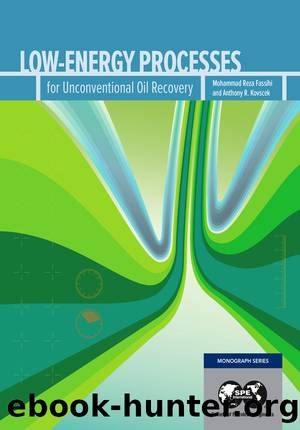Low-Energy Processes for Unconventional Oil Recovery by Reza Fassihi;Tony Kovscek;

Author:Reza Fassihi;Tony Kovscek;
Language: eng
Format: epub
Publisher: SPE
7.11 Performance Estimation
Once air injection begins, the temperature data from observation wells along with gas composition, oil production, and air injection can be used to estimate future production and monitor the success of the ISC.
7.11.1 Nelson and McNeil Methodology. Nelson and McNeil (1961) provided the basic concepts for estimating the average behavior of ISC in a field. Their proposed equations, which are based on âfrontal displacement,â were discussed previously.
7.11.2 Gates-Ramey Correlation. A simple method to consider the frontal displacement, thermally aided gravity drainage, steam distillation, oil swelling and viscosity reduction, and other significant mechanisms ahead of and adjacent to the burning front was proposed by Gates and Ramey (1980). The South Belridge field test was one of the first tests conducted in California using a single 2.5-acre five-spot pattern in the 700-ft-deep Tulare sand containing a 12.9 °API oil. Aside from being a technically successful test, it was the learning tool for many new projects. Gates and Ramey used the results of this test to develop the âoil recovery vs. volume burnedâ (ORVB) method. It indicates that the AOR passes through a minimum and that oil is recovered more rapidly than is indicated by a simple frontal displacement.
Download
This site does not store any files on its server. We only index and link to content provided by other sites. Please contact the content providers to delete copyright contents if any and email us, we'll remove relevant links or contents immediately.
| Automotive | Engineering |
| Transportation |
Whiskies Galore by Ian Buxton(41725)
Introduction to Aircraft Design (Cambridge Aerospace Series) by John P. Fielding(33022)
Small Unmanned Fixed-wing Aircraft Design by Andrew J. Keane Andras Sobester James P. Scanlan & András Sóbester & James P. Scanlan(32690)
Craft Beer for the Homebrewer by Michael Agnew(18087)
Turbulence by E. J. Noyes(7901)
The Complete Stick Figure Physics Tutorials by Allen Sarah(7272)
Kaplan MCAT General Chemistry Review by Kaplan(6828)
The Thirst by Nesbo Jo(6768)
Bad Blood by John Carreyrou(6482)
Modelling of Convective Heat and Mass Transfer in Rotating Flows by Igor V. Shevchuk(6359)
Learning SQL by Alan Beaulieu(6165)
Weapons of Math Destruction by Cathy O'Neil(6090)
Man-made Catastrophes and Risk Information Concealment by Dmitry Chernov & Didier Sornette(5883)
Digital Minimalism by Cal Newport;(5593)
Life 3.0: Being Human in the Age of Artificial Intelligence by Tegmark Max(5410)
iGen by Jean M. Twenge(5333)
Secrets of Antigravity Propulsion: Tesla, UFOs, and Classified Aerospace Technology by Ph.D. Paul A. Laviolette(5244)
Design of Trajectory Optimization Approach for Space Maneuver Vehicle Skip Entry Problems by Runqi Chai & Al Savvaris & Antonios Tsourdos & Senchun Chai(4962)
Electronic Devices & Circuits by Jacob Millman & Christos C. Halkias(4871)
